
Auto Tips & Advice
Air Pressure: what should I know?
General Guidelines
- Check the pressure of all your tires monthly, including the spare. Even if you don’t see any damage, tires can lose up to 1 psi - pounds per square inch - every month. This can be accelerated by air leaks due to accidental puncture, leaks in the valve or valve cap, or by wheel malfunction.
- Check your tire pressure before making a long trip.
- For best results, check your tire pressure when tires are cool– before driving the car or if it has covered less than 3 miles at low speed.
- If the tire is hot, add 4-5 psi to the car manufacturer's recommended pressure value (0.3 bar) or wait until it has cooled down, which is an average of three hours after parking the car.
- Never deflate a hot tire.
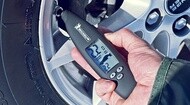
How do I check my tire pressure?
- Insert the pressure gauge into the valve stem on your tire.
- The gauge will “pop” out and show a number: that's the psi number.
- The hissing sound is air escaping the tire. It shouldn’t affect pressure substantially, unless you hold down the air pressure gauge too long.
- Compare the measured psi to the recommended psi.
- If the psi is above the recommended number, let air out until they match. If it's below, add air until it reaches the proper number.
Where can I find the recommended pressure for my tires?
- In the vehicle owner's manual.
- On a sticker on the driver's door or the gas tank door.
- Do not use the number on your tire’s sidewall, as this does not indicate the pressure needed in your tire.
About pressure gauges
- Be careful if you are using a pressure gauge provided in gas stations. The pressure gauge is often not reliable.
- Buy a high-quality pressure gauge and check its accuracy with a tire professional.
Getting it right is important
- Under-inflated or over-inflated tires can wear down faster than expected, have reduced grip, and can consume more fuel. It just takes a few minutes a month to help ensure your safety and the longevity of your tires.
Nitrogen: what are the benefits?
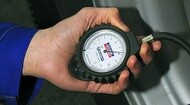
What is nitrogen?
Nitrogen is simply dry air with the oxygen removed. Air contains nearly 79% nitrogen already.
How is it used?
Nitrogen Versus Compressed Air
Most tires are filled with compressed air. But some tire retailers have started to put nitrogen into their customers’ tires. (Nitrogen is simply dry air with the oxygen removed. Air contains nearly 79% nitrogen already.) Because nitrogen replaces oxygen, less air can escape your tires, and your inflation pressure stays higher longer. Unfortunately, there are other possible sources of leaks (tire/rim interface, valve, valve/rim interface and the wheel) which prevent the guarantee of pressure maintenance for individuals using air or nitrogen inflation.
Nitrogen and compressed air CAN be mixed, if needed. Tires manufactured by Michelin are designed to deliver their expected performance when inflated with air or nitrogen, as long as the user respects the pressures recommended by the vehicle manufacturer on the vehicle’s placard or by the tire manufacturer.
The downside:
Unfortunately, there are other possible sources of leaks (tire/rim interface, valve, valve/rim interface and the wheel), which means there's no guarantee of maintained pressure with either air or nitrogen.
Tire inspection:
Note that, even if tires are inflated with nitrogen, the pressure and overall tire condition must still be checked frequently.
Valve: what should I know?
What is the role of the valve?
- It ensures the proper tire pressure is maintained.
- It blocks moisture from entering the tire.
- The valve cap is also important to maintain the pressure (high quality caps are recommended).
- The valve cap also helps to block dust particles from obstructing the valve.
Aging and damages
- Valves are usually made of rubber and therefore age with time.
- They can be damaged by high speeds and air can leak.
When should I change the valves?
Whenever you buy new tires.

How to check if you have enough tread left?
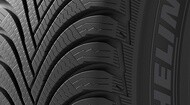
General
In order to effectively grip the road, evacuate water and maintain control, your tires need to have a safe amount of remaining tread. If the grooves in the tire design have almost disappeared, the tire will simply not grip the road as well. This is particularly dangerous in wet or wintry conditions.
- Plus, if you drive with tires under the legal tread limit, you may be fined.
- You should check the wear of your tires regularly. If your tires are approaching the legal limit or if you have any doubts, get them checked by a tire professional. Or see below how to check it yourself.
Three methods
1- Check the tread wear with a tread depth gauge
- Make sure the car is on hand brake and in first gear (for manual gearboxes) or park (for automatics).
- Check the depth of the main tread grooves in several places across and around the tire, using the gauge as instructed by its manufacturer.
- The legal minimum tread depth in the United States is 2/32nd's across the central three-quarters of the tread width and round its entire circumference.
2- Check the tread wear indicators
- Tires have tread wear indicators moulded into the base of the main grooves.
- When the tread surface is worn to the same level as these indicators, the tire is at the legal limit and should be replaced.
- Winter tires: MICHELIN® Winter tires have a ‘snowflake’ design to show the location of additional tread wear indicators. They are 0.15 inch high. Replace your Winter tires once they are worn down to the level of the 'snow' tread wear indicators.
3- Use the penny test
A- Take a penny and hold Abe's body between your thumb and forefinger.
B- Select a point on your tire where tread appears the lowest and place Lincoln's head into one of the grooves.
C- If any part of Abe Lincoln's head is covered by the tread, you're driving with the legal and safe amount of tread. If your tread gets below that (approximately 2/32 of an inch), your car's ability to grip the road in adverse conditions is greatly reduced.
Tire rotation: what should I know?
What is it?
During rotation, each tire and wheel is removed from your vehicle and moved to a different position to ensure that all tires wear evenly and last longer.
When should I do it?
Tires should be rotated based on your vehicle manufacturer's recommendation or every 6,000 to 8,000 miles. Monthly inspection for tire wear is recommended. Your tires should be rotated at first sign of irregular wear, even if it occurs before 6,000 miles. This is true for all vehicles.
Benefits:
Since the position of the tire on your vehicle can affect how it wears down, regular rotation helps ensure that tires wear evenly, extending the life of your tires and improving performance.

Tire alignment: what should I know? (also known as "Suspension alignment")
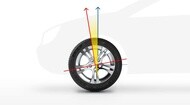
Tire alignment is a simple process, which may require slight adjustment of front and/or rear suspension components. If your alignment is off, your vehicle could be unsafe to drive.
When should I have my tire alignment checked?
- You’ve hit a sizable object on the road.
- You see a wear pattern developing on the shoulders (outer edges) of the tires.
- You notice a difference in your vehicle’s handling or when you are steering.
- When you replace suspension or steering components.
- At least every 4,350 miles.
A few example indicators:
- Your vehicle pulls or drifts to one side, when you are travelling on a straight, flat road with little cross-wind.
- Your steering wheel does not return easily after a turn.
- Your steering wheel remains at an angle when driving in a straight line.
Why is it important?
- To minimize wear and tear and to maximize driver and passenger comfort.
- To reduce wear on your tires, help increase their life and performance, and improve fuel economy.
- To improve handling and driving safety by reducing steering and stability problems.
How are wheels aligned? The details
There are three main adjustments made during alignment:
- Camber: if you’re viewing from the front of the vehicle, camber is the angle of the wheel, in degrees.
- Caster: if you’re viewing the side of a vehicle, the caster angle identifies the forward or backward slope of a line drawn through the upper and lower steering pivot points.
- Toe: it’s the difference in the distance between the front of the tires and the back of the tires.
Tire balancing: what should I know?
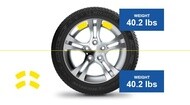
What is it?
- Sometimes when tires are mounted the distribution of weight of the tire+wheel assembly is not perfectly even all around the tire.
- A wheel is out of balance when one area is heavier or lighter than the rest. The result is bouncing or wobbling, which can decrease tread life, increase vibration, and cause stress on your vehicle.
- Tire balancing compensates for the weight differences to make sure that the tire weight is balanced. Tire professionals will add weights where necessary to counterbalance the tires.
When should I balance my tires?
- When a tire is replaced
- When a balance weight is moved or removed
- When you purchase new tires
How are wheels balanced?
- To balance a wheel, your mechanic uses a balancing machine to determine where the heavy spots are.
- Weights are then attached to the exterior or interior of the wheel to counteract centrifugal forces acting on the heavy areas when the wheel is turning.
Any advice?
If you ever feel bouncing, wobbling or vibrations, consult a tire professional quickly.
Tire Registration
Make sure your tires are registered to receive direct notification in the event of a safety-related recall.

Find a Dealer
Search by
Address, City or ZIP code

